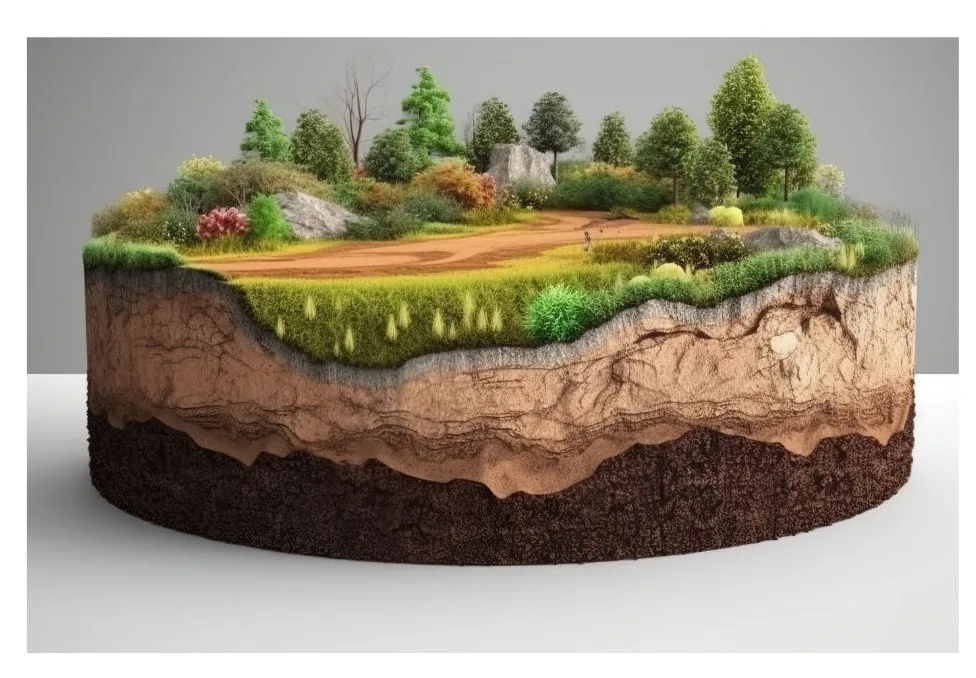Pedogenesis
Pedogenesis of Soil explains the factors and processes involved in the formation of soil. It involves the formation of soil from various factors such as weathering of rocks, influence of climate, geological movement, and activities of living organisms that shape the formation of soil.
Factors controlling the formation of soil are:
- Parent rock
- Climate
- Natural vegetation
- Topography
- Time
Parent Rock
Weathering of parent rock determines the mineral content of the soil, soil color, P.H. value, and composition of the soil. For example, soils formed by weathering salt with basalt are rich in iron and magnesium because of the presence of iron and magnesium. Its color is black, and since it is dominated by clay and silt its moisture-holding capacity is high. Soil is formed by weathering by quartzite which is a metamorphic form of sandstone, it is sandy, acidic, and rich in iron and ferric oxide. So it is red and has poor moisture retention as it is dominated by sand and gravel.
Climate
Climate determines the rate of weathering turns location and vegetation cover. In tropical and temperate humid climates, the rate of weathering is fast whereas in cold and dry climates, the rate of weathering is slow. Climate with temperature and rainfall also determines forest density which is the source of organic content of soil in hot and humid climates where forest density is high.
The organic content of soil is high whereas in dry content of soil is high and wherein dry and cold climates vegetation is scanty and low organic content is low. Translocation is the movement of soil particles across soil horizons in per humid climate. Downward movement is semi-dry and dry climate movement is upward under the influence of Capillary action.
Natural Vegetation
It determines the organic content of soil. If the surface is covered with dense forest. Nitrogen, phosphorous, and humus are high, and if forest cover is absent nitrogen, phosphorous and humus are low.
Orography determines a balance between pedogenesis and soil erosion and the presence or absence of water. On steep slopes erosion is faster compared to soil formation, soil is thin. Since thin soil cannot support dense vegetation. So organic contains also low, on moderate and gentle slopes. soil thickness is high as well as organic contents.
Time
Time determines the level of maturity of soil which is determined by the length/ duration of pedogenesis. If it is longer, the soil is matured and settled, and if the time of pedogenesis is shorter soil is immature. soil maturity is not well developed. However, times become natural as the soil forming process is arrested due to some unique orographic/climatic conditions like soil formation not not well developed.
Soil Forming Processes
Some of the important soil-forming processes are:
Weathering
Weathering is the chemical and physical decomposition and disintegration of rocks. It is fast in tropical and temperate humid climates and slow in cold and dry climates. Weathering of parent rock determines soil composition, soil structure, color, and P.H. value.
Translocation
The movement of soil particles across soil horizons is known as Translocation. Translocation includes downward as well as upward movement; downward movements are dominant in humid and per-humid climates. If downward movement occurs in the solution state, the process is called leaching. Podzolization is the process of downward translocation in a cool temperate continental climate covered with Taiga/ Coniferous forest.
Lateralization
Lateralization is prominent in tropical hot and humid climates with seasonal rainfall. In this climate silica and base are removed from the E horizon and deposited in the B horizon. E horizon is rich in oxides, iron, and aluminum, such process is called lateralization/desalination, and soil is called laterite soil and feral soil.
In dry regions with capillaries action process of translocation is upward carbonates and chlorides move upward. This process is called calcification, if there is upward movement of carbonates and chlorides of sodium this process is called Salinization.
Bio-decomposition
It is a bacterial activity that is responsible for the bio-decomposition of dead plants and animals and the production of nitrogen, phosphorous humus, and humic acid, Bio-decomposition is fast in hot and humid conditions and it is slow in cold and dry climates.
Gleying
It occurs in water-saturated conditions is bio-decomposition of dead plants and animals in water-related conditions of lowlands is known as gleying. Gleying is responsible for the formation of peat soil. It is also called Hydromorphic.
Classification of Soil
Russian pedologists provided a zonal classification of soil. This scheme of classification of soil. This scheme of classification divides soils into 3 categories:
1)Zonal Type
2)Intra-zonal Type
3)A-zone Type
1. Zonal Type
These soil types are associated with climate and vegetation zones. The following are zonal types of soil:
Podzols
Brown earth
Tundra Soil
Chernozem/black soil
Sierozem
Grumusols soil
Ferralitic soil

Podzols – This is associated with a cool temperate continental climate covered with Taiga/coniferous forest. Soil is formed by the process of podzolization in which oxides of iron and aluminum with base are translocated from the soil, E horizon to B horizon. Soil is rich in silica and acidic in nature due to forest cover soil being rich in organic content.
Brown earth– It is associated with temperature climate with seasonal rainfall. The region is covered with a temperate deciduous region. This soil is also formed by the process of Podzolization. However, intensity is low as one of the seasons is dry.
Tundra soil– It covers the sub-polar region which is covered with ice during the winter season during start and cool summer as the ice melts lichens and mosses develop. The organic content of the soil is low.
Sierozem– Soil is associated with tropical and temperate deserts which have low vegetation. The base content of the soil is good, organic content is low. If water is assured due to the presence of a base, the soil is fertile.
Grumusols soils– These are associated with tropical grassland in which grasses are tall and seasonal soil is rich in base and organic content. Organic content is relatively thin compared to Sierozem. This soil cracks during dry seasons.
Ferralitic soil– It is associated with a tropical hot and humid climate with seasonal rainfall process of laterization is responsible for the formation of soil. In the process of laterization silicon and base are removed from soil. Soil is rich in oxides of iron and aluminum.
2. Intra-zonal soils
It is formed due to the dominance of local climate/rock structure. Three types of intra-zonal soil are identified:
hydro morphic Calcimorphic Halomorphic
Hydromorphic- It is formed in lowlands covered with forest and saturated with water. Soil is formed by the process of Gleying, the soil is also called peat soil.
Calcimorphic- This is formed by the decomposition and disintegration of limestone which is rich in calcium carbonate.
Hylomorphic- This soil is rich in chloride. This soil is formed in semidry and dry regions with irrigation and water logging conditions due to rapid evaporation. Chlorides move upward with capillary reaction and are deposited on and close to the surface. This problem is common in Punjab, Haryana, and Western Uttar Pradesh.
3. A-Zonal soil
It is immature soil regur soil and lithosols are important. A-zonal soils are loose sand associated with dunes and sandy deserts. Litosols are angular rock fragments associated with high latitude and altitude. cold regions which suffer weathering of rocks due to periodic, freezing and melting of water. Even alluvial soil of India (Khadar/ new alluvial) fall into A- zonal soil.

